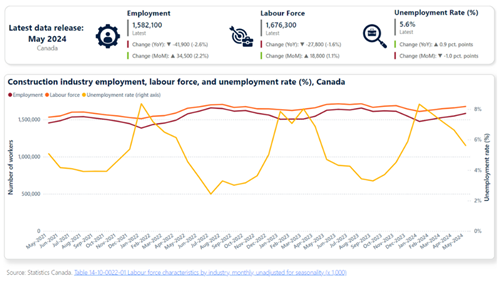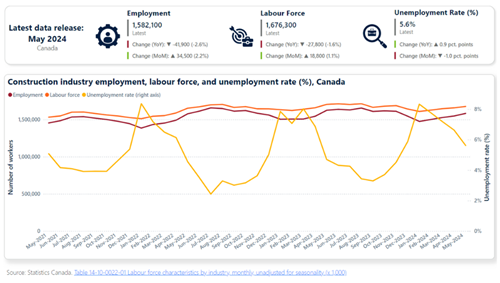
Employment growth slows in May, but young workers are more in demand
Posted on June 21, 2024
Key construction employment metrics are trending lower in May 2024 compared to the same period in 2023.
New Labor Force Survey (LFS) data released by Statistics Canada shows that employment and labor force numbers are lower in May 2024 than in May 2023. Employment reported a contraction of 41,700 workers, or – 2.6%, during the last 12 months, while the number of persons in the construction workforce decreased by 27,900 or -1.6%, in the same period. Consequently, the unemployment rate in the industry increased from 4.7% in May 2023 to 5.6% last month.
In May, the national construction labor force was 1,676,300 workers, while employment was 1,582,100 workers.
 Provincial data varies
Provincial data varies
It is worth noting that although headline employment data is lower this year compared to May 2023, these numbers remain in line with historical levels. Below are some of the main variations reported across provinces.
Employment declines were largest in Ontario (-33,700, -5.5%), Alberta (-13,500, -5.4%) and Manitoba (-3,100, -5.4%), while Prince Edward Island (+ 1,100, +15.1%), Nova Scotia (2,000, +5.2%) and New Brunswick (1,300, +4.0%) reported the biggest year-over-year gains.
Labor force changes over the past 12 months ranged from an increase of 15.2% (or 1,200 workers) in Prince Edward Island to a contraction of 5.0% in Ontario. At -32,300 workers, Ontario’s labor force decline was by far the largest in the country and more than offset gains recorded in six other provinces.
Unemployment rates in construction across the provinces ranged from a high of 15.1% in Newfoundland and Labrador to a low of 3.7% in Quebec. Every other province reported rates of at least 5.0%, with Alberta (7.9%), Saskatchewan (8.1%), New Brunswick (8.2%) and Newfoundland and Labrador reporting rates of approximately 8% or more.
Overall employment has fallen among men and women, but is rising among younger workers
Both men and women saw construction employment decline by 2.6% nationally in May. Most notable among these trends is a significant and sustained increase in female employment in Quebec. Women’s employment increased by 40% year-on-year, and by nearly 11% month-on-month. May marked the fifth consecutive month in which female employment has increased by 10% or more in the province. Employment growth among women was also strong in British Columbia in May, with the province adding more than 15% to female employment compared to the previous month.
Also worth mentioning is the increase in employment among young workers (ie those aged 15 to 24) in May. Over the past 12 months, employment in this group grew by 8.7% nationally, with Quebec and Newfoundland and Labrador reporting increases of 75% or more, and Prince Edward Island and Nova Scotia both reporting increases of at least 25%. Compared to April 2024, employment in this group increased by 11.8% nationwide.
Employment among young women (ages 15 to 24) increased by 30.5% nationally, with some provinces (ie Ontario, Quebec and British Columbia) reporting increases of 75% or more over the past 12 months . Rapid employment growth among young women has translated into the highest participation of women in the construction industry since the first publication of the Labor Force Survey in 1976.
Finally, youth employment increased by 6.7% nationally and more than 100% in Quebec, Newfoundland and Labrador over the past 12 months. On a monthly basis, employment in this group increased by 9.8% nationally, with the largest increase reported in Saskatchewan (64.1%).
This article was written by Klayton Gonçalves, Senior Economist and Head of Business Intelligence for BuildForce Canada. It was first published in BuildForce Job Market Corner Blogand we reprint it here with permission.
#Employment #growth #slows #young #workers #demand
Image Source : www.link2build.ca